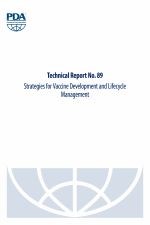Technical Report No. 89: Strategies for Vaccine Development
Premium Members: to claim your annual free technical document download, email [email protected] and indicate the document you wish to claim.
- Format
- PDF Single User
- Member Price
- $180.00
- Nonmember Price
- $325.00
- Government Price
- $180.00
Please sign in or become a member to purchase items from the PDA bookstore.
This report describes different strategies that can be applied to manage the development and lifecycle of vaccine products. The concepts covered are intended to apply to different types of vaccines, for which "real world" examples are provided. In some cases, the strategy may involve extensive retrospective work that may be required for legacy vaccine products. Building product and process knowledge and including control strategy elements are particularly important for such complex biological products as vaccines. This report addresses that issue by including strategies that can be applied in early development to licensure and those that are focused on lifecycle management of marketed products.
Specific aspects of control strategies that are particularly relevant to both prophylactic and therapeutic vaccines are covered in this report, including setting and managing specifications, managing process parameters with respect to classification and lifecycle management, and considering comparability requirements.
Available to download. Prior to purchase please view the download instructions and Terms of Usage.
Format: PDF (1 file 1.05 MB)
Click here to order paper ship version (Item no. 01079).
*To purchase licensing, please contact PDA at [email protected].
Table of Contents
Table of Contents:
Click here to download >>> Detailed Table of Contents- Introduction
- Abbreviations
- Existing Guidance Documents for Vaccines
- Control Strategy From Process Development to Cavvine Lifecycle Management
- Comparability Assessments:Enabler for Changes During Development and After Approval
- Considerations for Vaccines Lifecycle Management
- Conclusion
- References

